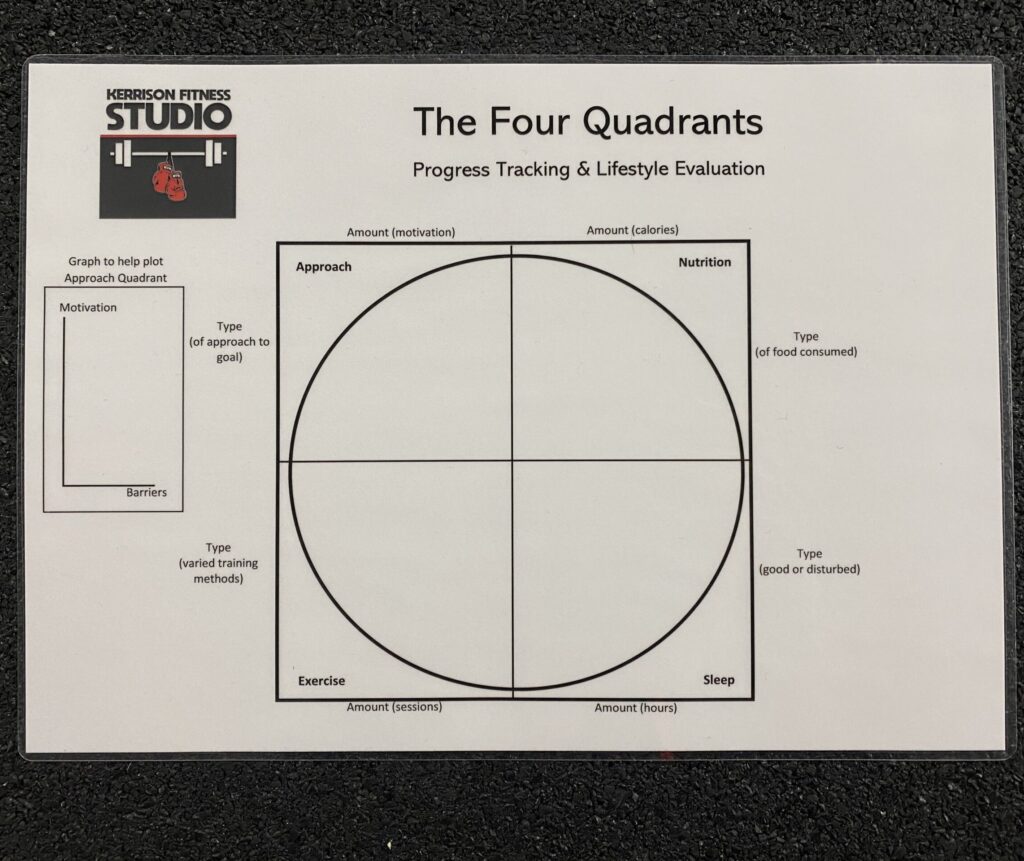We always emphasise that results don’t just come from the gym; it’s important not to neglect the many other lifestyle factors that contribute to your results. Listening to our clients, we developed a progress tracking and lifestyle evaluation tool to help our members stay on the right track.

The Four Quadrants looks at the four majorly influential factors of individual’s lifestyles and asks them to self-assess their own to plot on the graph. Conveniently, we find that each of the quadrants can be measured by two variables, ‘Amount’ and ‘Type’. It is up to the individual to decide the duration they wish to assess whether it be every day, per week or per month (we tend to track this weekly for our clients that like to analyse how well their lifestyle is complementing their exercise programmes).
In regards to each; Nutrition is the amount of calories consumed per day and the type of food consumed in a day as the assessment, Sleep is the amount of hours sleep you got alongside the type of sleep it was (whether it was good, deep sleep or disturbed and broken), Exercise is the amount of sessions carried out in a week with the type being the variety of training methods used (the more variety in an exercise programme, the better). Approach refers to mental approach to the overall goal. This can be a difficult one to assess using the ‘Amount’ and ‘Type’ variables so we added a small graph off to the side which asks the individual carrying out self-assessment to determine what their motivation is for their goals and what barriers to they have. For example, a person may be highly motivated to become healthier for the purpose of keeping up with their children or grandchildren but a barrier may be that the school run makes it difficult for them to fit exercise in or have time to eat a proper meal. You must then ask yourself whether or not you are able to tackle that barrier in the short, medium or long term and plot that section of the graph from there.
Once you have put an ‘X’ in each of the quadrants, have a look at the graph as a whole. This is your lifestyle and how positively it works alongside all the workouts and dedicated choices you are making towards your ambitions. The closer all of the plots are to the centre of the graph, the more efficiently you are heading in the right direction. What we often find is that there will be one or two anomalies; this is helpful because it allows the individual to create a plan of action to solve the anomaly and bring the whole process of getting closer to results all together. It’s important to understand how sensitive each of the quadrants are to one another; by having one out of balance, there can be a chain reaction, perhaps unknowingly, which throws the whole programme out of line. For example, if the Exercise section is off because insufficient levels of exercise are present, the right levels of positive hormones, such as endorphins, will not be produced. Without this, the mental Approach suffers and the individual loses motivation. Without motivation, sticking to disciplined choices such as eating the right foods and avoiding the junk becomes more challenging, causing the downfall of the Nutrition section. With poor nutritional intake, sleep can suffer as the body isn’t settled. Poor sleep is associated with poor performance in exercise and so the circle goes on.
To conclude, health and fitness is about finding the right balance for you. Don’t expect everything to be immediately perfect but moving forward with the intention of improving, little at a time, will begin to put everything in the right place. Long-term and sustainability are keywords for healthy practice.
